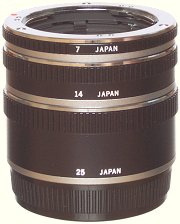Close-up and macro photography for entomologists
Extension tubes

On most lenses, the manufacturers provide a focusing mechanism that extends only a few millimetres, partly to keep down costs and partly to restrict the lens to extensions for which its optics are optimised. To provide additional extension, one or more extension tubes can be added between the camera and the lens, to make the lens focus at closer distances and therefore produce higher magnification.
Extension tubes are metal tubes with a rear-lens mount at one end and a camera-body mount at the other end. They are available for 35 mm and roll-film cameras. For 35 mm cameras, they often come in sets of three which allow magnifications up to ×1.0 with a 50 mm lens. For example, the Olympus OM tubes are 7, 14 and 25 mm, while the Zuiko 50 mm lens has 7.5 mm of extension built-in, and so in various combinations they provide from zero to 53.5 mm with no gaps. However, not all sets are so convenient – the Vivitar AT-21 set of 12, 20 and 36 mm provides greater magnification but with gaps in the range.
Tubes with variable extension are available for a few cameras, including Olympus, and provide a more robust alternative to an extension bellows.
Image quality depends on the lens with which they are used – some lenses are satisfactory, others give pronounced field curvature and poor definition at the edges. In general, it is the fastest and widest lenses that give the poorest results.
Tubes are rather awkward to use, as different combinations have to be assembled and used together with the focusing movement of the lens in order to obtain particular magnifications.
Modern tubes include couplings for automatic diaphragm, automatic exposure and autofocusing; older tubes may provide fewer or none of these features. The additional extension requires exposure compensation, but this is normally handled by the camera's TTL exposure meter.
Macro lenses already incorporate much more extension that a normal lens, but they can also benefit from extension tubes. A 50 mm macro lens that focuses unaided to ×0.5 covers the range ×0.5 to ×1.0 when used with a 25 mm extension tube; a 52.5 mm extension tube performs the same function for a 105 mm macro lens.
Lenses that incorporate floating elements for better performance at short distances (like some macro lenses and fast wide-angle lenses) should be set for close focus, not for infinity focus, when they are used with extension tubes.
Not all lenses are suitable for use on extension tubes; the construction of some zoom lenses and macro lenses requires their rear element to be at a fixed distance from the film.
Alternative uses
A short extension tube can act as a makeshift lens hood to protect the rear element of a lens that is being used on a reversing ring or a coupling ring. A manual extension tube fitted to a reversed Olympus OM lens converts the automatic diaphragm to click-stop operation, allowing the lens to be stopped down when mounted on a reversing ring.
Good points
- Cheaper than a macro lens
- Simple tubes are not expensive
Bad points
- Awkward to add, remove and combine to change magnification
- Expensive if autoexposure and autofocus required
- Variable tubes have a large minimum extension
Send comments or questions to Alan Wood
![]()
![]()
Created 27th December 1997 — Updated 24th April 2001
Copyright © 1987–2001 Alan Wood